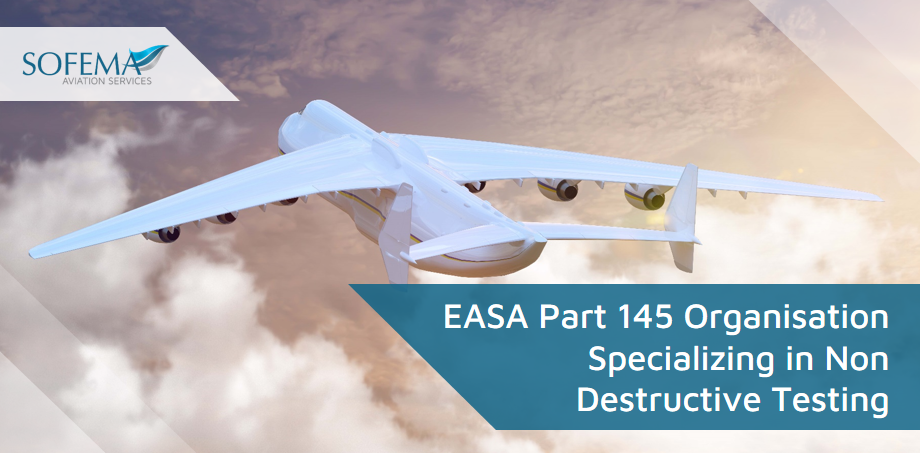Sofema Aviation Services (SAS) www.sassofia.com considers the function, role and responsibility of an EASA Part 145 NDT Organisation.
Introduction
The European Union Aviation Safety Agency (EASA) Part 145 regulation outlines the requirements for maintaining aircraft and their components. Understanding the specific responsibilities and release procedures is crucial for organizations specializing in non-destructive testing (NDT).
Part 145 Organisation Overview
A Part 145 organisation is responsible for maintaining the aircraft’s airworthiness and components. This includes performing maintenance tasks, inspections, and releasing the aircraft or components back to service. For organizations specializing in NDT, the scope of work involves performing inspections using various NDT methods to ensure the integrity of aircraft structures and components without causing damage.
Certifying Staff and Qualifications
The qualification and responsibilities of certifying staff vary depending on the class rating of the maintenance task. Here’s an outline based on different categories:
Aircraft (Class A)
- Certifying Staff: Certifying staff must hold a Part 66 license (B1, B3, C, or L).
- Qualification System: Personnel must follow Part 66 regulations.
- Release Procedure: Maintenance release is documented either on the aircraft technical log or through an aircraft release to service statement.
- NDT Procedure:
- The NDT inspector performs the NDT task and signs off the work order.
- The appropriately qualified certifying staff (B1, B3, C, or L) releases the aircraft, which may include associated tasks such as panel removal and reinstallation.
Engines (Class B)
- Certifying Staff: Engine certifying staff qualified according to company procedures; a Part 66 license is not required.
- Qualification System: Must comply with the competent authority’s requirements.
- Release Procedure: Done on an EASA Form 1 or through an internal release document for internal use.
- NDT Procedure:
- The NDT inspector performs the NDT task and signs off the work order.
- The engine certifying staff releases the work performed on the engine, including the NDT inspection, on an EASA Form 1.
Components (Class C)
- Certifying Staff: Components certifying staff (CCS) are not required to have a Part 66 license.
- Qualification System: Must follow the procedures established by the organisation.
- Release Procedure: Performed on an EASA Form 1 or an internal release document.
- NDT Procedure:
- The NDT inspector performs the NDT task and signs off the Work Order / Engineering Order.
- The CCS releases the work performed on the component, including the NDT inspection, on an EASA Form 1.
Specialised Services (Class D1)
- Certifying Staff: Specialised services certifying staff, qualified in accordance with EN4179; Part 66 license is not required.
- Qualification System: Procedures established by the organisation in compliance with EN4179.
- Release Procedure: Done on an EASA Form 1 or another form of release to service as defined by the organisation in the MOE and approved by the competent authority.
- NDT Procedure:
- The NDT certifying staff performs and releases the NDT task on an EASA Form 1 or another approved form.
Key Considerations
- Non-EU Organisations: For non-EU organisations approved by EASA Part 145, the Part 66 license can be substituted with a national license in accordance with EASA Part 145 Appendix IV.
- Scope of Work: The organisation must ensure that the approved scope of work includes NDT inspections for the specific aircraft, engine, or component types.
- Compliance: Adherence to 145.A.30(f) for the qualification of NDT personnel is mandatory.
EASA Part 145 NDT Organisation key qualifications and requirements:
Approval and Certification:
- The organisation must be approved by EASA under Part 145, which entails undergoing an initial certification process and subsequent audits.
- Specific approval for NDT methods should be included in the organisation’s scope of work.
Personnel Requirements:
- NDT staff must be qualified and certified according to relevant standards such as EN 4179 or equivalent (e.g., NAS 410).
- Personnel must have appropriate experience and training in the specific NDT techniques they will be performing (e.g., ultrasonic testing, radiography, eddy current testing).
- The organisation should have a designated Accountable Manager responsible for ensuring compliance with EASA Part 145 requirements.
Training and Competency:
- Continuous training and competency assessment programs must be in place to ensure NDT personnel maintain and update their skills and knowledge.
- Specific training records for each NDT inspector must be maintained and kept up-to-date.
Quality System:
- A robust quality assurance system must be established, including regular internal audits, inspections, and management reviews to ensure compliance with EASA regulations.
- The quality system should address corrective actions, preventive actions, and continuous improvement processes.
Facilities and Equipment:
- The organisation must have suitable facilities and equipment for conducting NDT inspections. This includes ensuring that all equipment is properly calibrated and maintained.
- Environmental conditions (e.g., lighting, cleanliness, temperature) must be controlled to ensure accurate and reliable NDT results.
Documentation and Records:
- Proper documentation procedures must be in place for recording inspection results, calibration records, training records, and maintenance records.
- The organisation should have procedures for the control and storage of NDT inspection records and related documentation.
Procedures and Manuals:
- Detailed procedures and manuals must be developed for each NDT method used, specifying how inspections are to be conducted, evaluated, and reported.
- These procedures must comply with applicable standards and regulations and should be regularly reviewed and updated as necessary.
Safety and Compliance:
- The organisation must ensure compliance with safety regulations and implement procedures to manage and mitigate risks associated with NDT inspections.
- This includes adherence to occupational health and safety standards and handling hazardous materials, if applicable.
Communication and Coordination:
- Effective communication and coordination mechanisms must be established between NDT personnel, maintenance staff, and other relevant departments to ensure seamless integration of NDT activities within the overall maintenance operations.
External Audits and Oversight:
- The organisation must be prepared for regular audits and oversight by EASA or other regulatory bodies to ensure ongoing compliance with Part 145 requirements.
- Any findings from these audits must be addressed promptly with appropriate corrective actions.
Meeting these qualifications and requirements ensures that a Part 145 organisation specializing in NDT inspections operates safely, effectively, and in compliance with EASA regulations.
Next Steps
Follow this link to our Library to find & download related documents for Free.
Sofema Aviation Services (www.sassofia.com) and Sofema Online (www.sofemaonline.com provide EASA Compliant Regulatory & Vocational Training covering Initial & Continuing Airworthiness. Please see the websites or email team@sassofia.com
Tags:
Part145, MaintenanceCertifications, AviationStandards, AircraftInspection, QualityAssurance, AviationRegulations, EN4179, MaintenanceOrganisation, AircraftMaintenance, Aircraft, AviationSafety, Aviation Compliance, Non-Destructive Testing (NDT), sasblogs, Airworthiness, EASA, aviation, Aircraft Maintenance





